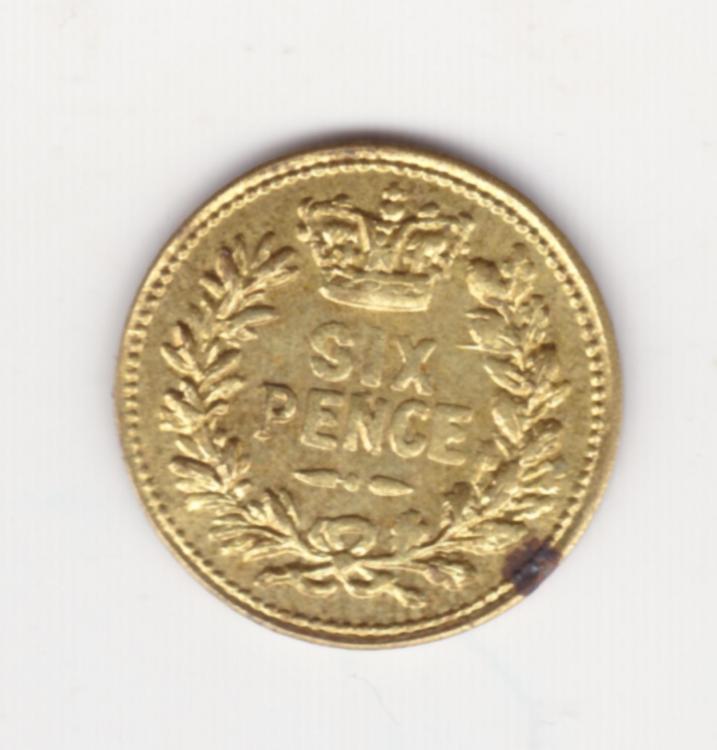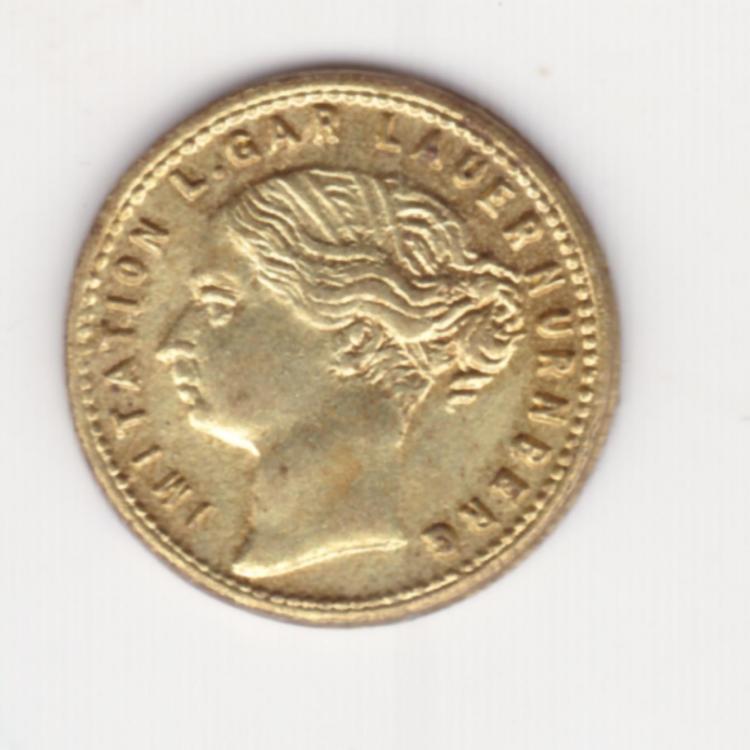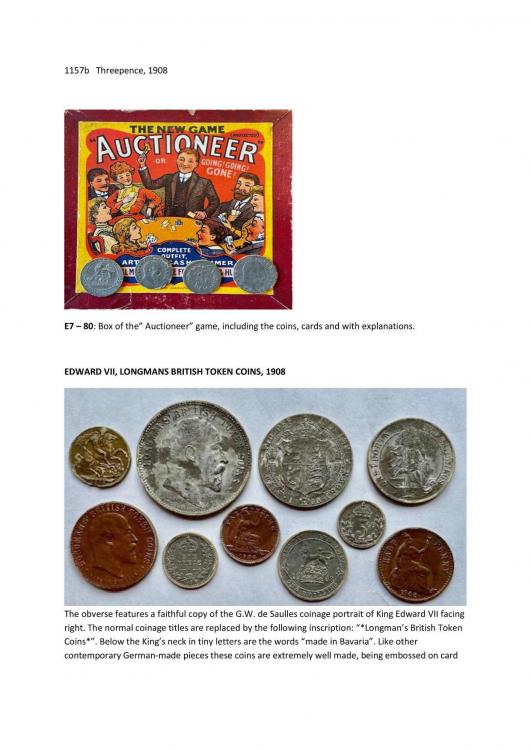|
|
The current range of books. Click the image above to see them on Amazon (printed and Kindle format). More info on coinpublications.com |
|
|
-
Content Count
1,737 -
Joined
-
Last visited
-
Days Won
43
Posts posted by DrLarry
-
-
8 hours ago, copper123 said:It's brass
Ok then it is the 430 they are classed as Rare one R the iron ones are RRR I have not yet taken a good look at mine to see if there are any variations
One small thing I have noticed with the ones I have is that the alloy is quite reactive and copper begins to build up a little so keep them dry and clean
-
16 hours ago, copper123 said:it is #430 section 11 copies of Lauer : L Gar Lauer attributed posibibly to an unknown english manufacturer (Hawkins 1960) brass also reported in white plated metal unseen by Rogers #430 a .
I note that there is a touch of corrosion on the reverse could you put a magnet to is see it it is brass? that looks like rust
-
-
-
4 hours ago, copper123 said:Yes its often interesting how the ones with no coating show no sign of having been played with. I think the coated must just disappear to a powder or as suggested in tin becomes a grey allotrope
-
-
30 minutes ago, oldcopper said:I saw it at the LCA auction where it was brown, it went to pink pre-slabbing, a great process whatever their secret recipe, as it turned a nothing special coin (still sold at ~£1K though) into a $6.4K one a few years later.
that is just ridiculous I suppose it is the same debate we were having the other day on toning in silver coins and that awful blue they get by chemically altering the surface.
-
 1
1
-
-
1 hour ago, oldcopper said:Wow! HA PR64 no colon 1841 with gorgeous pink toning - went for nearly $6.5K in 2017.
Oh wait, it's the same coin!
How did it turn from a pink to a brown? it is the same coin same blemishes at least
-
-
-
-
-
Reading through Thomas's book has spurred me on to catalogue the toy coins of card and plastic. I don't have a lot but pick them up now and again for the fun of it. Here are a set I cannot find listed in Rogers and because they are part plastic (not the notes and the cheque book deposit book ) they are not in his book. The must date from at least 1957 as the date written in the cheque book is this date. They are quite early for plastic used since about 1949 and have educational value. The half penny, penny, and threepence in copper the sixpence, shilling, florin and half crown in silver
At least two issues are likely an older Green paying in book and cheque book in one and the later Blue version. I cannot see any clue to the dates other than that mentioned HELP PLEASE
-
 1
1
-
-
Yes I can imagine you collectors that have been collecting for years would have a hell of a problem cataloguing. Even and only after 8 years collecting it has grown to a point that if I buy nothing else I have started listing and photographing now just so the collection has some reference points. I could say that I would not mind "beyond the grave" if the rarer varieties were mis sold, even for the charity, but I will still be annoyed to think it might happen in advance of sudden demise.
I have to admit I do find the process of sorting and listing coins for sale very tedious, even if it helps. It is the sheer number that is so daunting. But this conversation might spur me on to just get rid.
-
 2
2
-
-
is it a Pea or a bean of some kind ?
-
Here is a new variety I'd bet none of us new about
https://www.ebay.co.uk/itm/394561585577
GREAT BRITAIN UK 1862 HALF PENNY VARIETY" 8" in DATE IS TO RIGHT OF LIGHTHOUSE
I find it hard to think the 8 can ever get to the left
-
 1
1
-
-
if you want a free copy of the book by Thomas Engelen on cardboard coins register on the link below and search for cardboard coins. It is fascinating and astonishing sometimes that these paper coins survive and often in such wonderful condition. It connects through games and educational sets the learners with coinage when coins wee important and essential in lives. I suppose these days you just give the kids a credit card ( old fashioned) or more realistically a phone and it begins to control the lives from year dot to death.
Welcome to the Internet Archive, one of the largest digital libraries in the world and home of the history of the Web!
We’re so glad you’ve decided to join our community of digital archivers from around the world. With your free account you can enjoy:
- 4.6 million books
- 6 million videos
- 14 million audio items (including 220,000 live music concerts)
- 580,000 software titles
You also have the ability to leave reviews, connect with other patrons, and even upload your own material to the collections. Want to jump right in? Here’s a quick guide to using your account!
As a 501c3 nonprofit dedicated to sustaining our digital history and culture for generations to come, we make all of our collections available for free. Your support is essential to helping the Archive survive, thrive, and grow—so if you find our resources useful, please chip in to help us ensure Universal Access to All Knowledge.
Thanks for joining us, and enjoy the archive!
The Internet Archive Team
www.archive.org -
On 4/10/2023 at 10:04 AM, copper123 said:Does anyone know what the metal is coating the "Silver" coins that Lauer produced my best bet is aluminium but I dont know if anyone has looked into it - I am pretty sure its not a thin coat of silver .
Rogers book would probably tell me but I don't have a copy....
I heard back from Thomas about the coatings and the references are in the German Toy Coin book by Gunter Achoff
here is his reply :
Coatings by Lauer : Lauer produced over a long period of time & varied the coatings meanwhile. You ll find a good guidance in the “Deutsches Kinderspielgeld” with most produced were Uncoated (“Natur”), or coated with tin or nickel, more rarely silver. The “golden” coins are mostly made of brass, if coated with messing. See series 24, 26, 28, 30 and 32 especially.
-
-
16 hours ago, blakeyboy said:Tin suffers from 'tin pest'- below about 13˚C the white tin allotrope really wants to be the grey powdery form.
There are videos of this spontaneously happening in a freezer.
interesting I always thought it was a humidity related issue thanks for that
-
17 hours ago, copper123 said:Well depends how much , tin is fairly unstable but given its cost probably the most likely .
Would explain why most silver coins are now in a poor state .
Pretty sure they have an iron core...
iron yes or zinc or this "white metal"
-
 1
1
-
-
1 hour ago, Rob said:Depends on when they were made. Prior to 1883, aluminium was not commercially available and effectively a precious metal given the cost of extraction and refining. I'd say nickel or tin were more likely in this instance. Tin plating is surely the cheapest method.
I agree I would think Aluminium would have been too expensive I too might go with some alloy of tin and nickel tin is pretty easy to control melting at such a low temperature the only thing that makes me question tin is it is pretty reactive and will quickly degrade ( which may explain some of the finds which may have dried to the oxide and rubbed off quickly) the lustre is still very strong after 140 years on most. They were manufactured between 1870 and most in the 1880's
-
I have only had a very brief glimpse at Rogers and so far cannot see much reference to materials . I will ask Gunter and Thomas they may have looked into it . It is an interesting question
-
3 hours ago, Iannich48 said:Davies does not list any different numbers of pearls, just the position of the top cross. Probably blockages like you said.
Thank you, yes I think that is all it is
 Coinpublications.com
Coinpublications.com




.jpg.70f446b42b70d8e308897eb7e2b98e64.jpg)
.jpg.627c229e4a68e8182560c08474972704.jpg)
.jpg.00c161e9958ef0e550540072ec9b0f20.jpg)
.jpg.6dd72e24f04a97910dcdf2ec478a9bdc.jpg)
.jpg.e20c64de6334712ace0bd3868dd3a9bd.jpg)
.jpg.e66b2c57605928027718ec37605e49c2.jpg)
.jpg.e6ae64a04bb2f1e36c8a12331392860f.jpg)
.jpg.7b1fafbbe78fb2a9ddd9e74003546dd3.jpg)

.jpg.8a135b8bb1b3d18f23a9b264bdea592f.jpg)
.jpg.ac58c56977c9db4b15f9e0a6e0a5cb4e.jpg)
.jpg.4a74a40d372b502fac1a93c61c6851a8.jpg)
.jpg.8c07cf7904e42a8266f36781ceb849b7.jpg)
.jpg.1ee37c82cde39747b9d34222e4f7afcb.jpg)
.jpg.01f587ee6292fd86aa4d9d82cc6b823c.jpg)
.jpg.8222430a4117cee41dafeb3bbb01a36f.jpg)
.jpg.dbea3db80e4edce36c898056a667a7ab.jpg)

.jpg.c453aeecb2aa5b68d96bf6f47090e5a6.jpg)
.jpg.5ecdc70acace69b645bc3e2589065455.jpg)
TOY COINS
in Free for all
Posted
it is always useful to post close up pictures if you find anything unusual about these toy coins , more often than not a simple explanation becomes clear . I think the question I asked about if there were two obverse portraits is more likely simply the result of a slightly deeper strike in the solid line bust and a weaker one in the vignette type . I noticed latter there is a reduced impression of the border dentils so likely with a slightly harder pressing the result would have been the same.